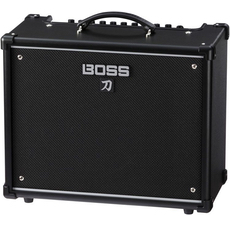 It’s hard not to see the Boss Katana 50 as a major player in the sub-$500 practice/small gig amp market.
It’s hard not to see the Boss Katana 50 as a major player in the sub-$500 practice/small gig amp market.
Intro
Every once in a while a product comes along that makes you rethink the entire genre. I don’t think I’m overstating the case when I say that the Boss Katana amplifier series fits that description. Sure, every year someone claims to have a new revolution in amplifier modeling, but let’s not forget that the folks at Boss/Roland started amplifier modeling years ago, so they bring some experience to the modeling arena. With the Katana series, Boss ups the ante with the balance of quality and price. Let’s take a look at the Katana 50 combo amplifier to see this in action.
Specifications
The Boss Katana 50 is a 50W combo amplifier with selectable power ranges from 50 to 1/2 watt. There are five modes available: acoustic, clean, crunch, lead, and “brown” (their take on 80s rock tones). It is a single input amp with a 1×12″ speaker. The main controls include a 3-band EQ, gain, volume, boost/mod selector, boost/mod level, delay/FX selector, delay/FX level, reverb selector, reverb level, tap tempo, master volume, power control, and channel selector. On the rear panel, there are Aux In, Phones/Recording Out, USB, and Foot Control input jacks. Engaging the Phones/Recording Out defeats the internal speaker. It weighs just shy of 26 lbs
Performance
Rather than modeling specific amplifiers, the Katana has general options that capture the most common amp sounds that guitarist need; clean, crunch, and lead, though there is an EVH-esque tone with the aptly named “Brown” sound. The “acoustic” setting turns the Katana into a dedicated acoustic amp (note: it’s not meant to make an electric guitar sound like an acoustic, though if you have piezo pickups built in (like on my Ernie Ball Petrucci), then this setting works really well.
While you can get a lot of mileage out of the Katana in its stock form, you want to make sure to incorporate the Boss Katana Tone Editor, which really opens up the options available for the Katana series. The Tone Editor lets you make presets that bypass some of the inherent limitations of the amp. For example, you can design presets that use distortion and modulation effects simultaneously (not an option without the software).
Once you integrate the Tone Editor software, the effects options are opened up signifcantly. Numerous overdrive and distortion emulations are included, such as Blues Drive, Overdrive, Natural OD, Warm OD, and Turbo OD. You’ll also find non-Boss overdrives such as Rat (Proco Rat), ’60s Fuzz (Fuzzface), and T-Scream (Ibanez Tube Screamer), so obviously there’s a bias towards Boss effects (not a bad thing), but the options are pretty massive. Mod effects include chorus, flanger, phaser, and tremolo. Other effects include compression, EQ, limiter, octave, T-wah, and pitch shift. Numerous delay effects are included: digital delay, SDE-3000, analog delay, tape echo, and modulating . Reverb types included plate, room, hall, spring, and modulating.
And do make sure you update the firmware to v2 – you get expanded effects options (including some cool new effects like the Roland SDE-3000 and MXR Phase 90) including effects loop placement. New options for the emulated output, global EQ, and cabinet resonance adjustments are also available.
Enough about that – how does this thing sound? It is a guitar amp after all. While tone is obviously very subjective, I say without hesitation that the Katana 50 (and its big brother the Katana 100) are easily some of the best modeling amplifiers that I’ve ever heard. No, it’s not on par with an Axe-Fx or Kemper, but then again, those pieces of kit are in the +$2k range. This is a $220 amplifier. I have used the Katana in a wide variety of gigs, from coffee shops to churches to cover band shows, and every time I’m impressed by its tone, portability, and versatility.
And it has a built-in kickstand. Seriously – sometimes it’s the “little things” that make a product just right.
One suggestion I could make for improvement is that I see no need for the phones/recording out jack to defeat the internal speaker since there is an option with the main power control to turn the speaker off. If you want to use emulated out it would be nice to have the option of keeping the internal speaker engaged.
Final Thoughts
For a $20 bill over $200, it’s hard not to see the Boss Katana 50 as a major player in the sub-$500 practice/small gig amp market. It’s a crowded space, but the Katana 50 has quickly risen to the top of the mountain. If it cost $600, it would still be a great bargain, but at $220, it’s a no-brainer.
Name of Gear: Boss Katana 50
List Price: $219.99
Manufacturer Info: Boss/Roland Corporation; boss.info
Pros: Incredible value; wide range of tones and effects; light
Cons: Redundant for phones/recording to defeat internal speaker; separate boost/mod controls would be nice